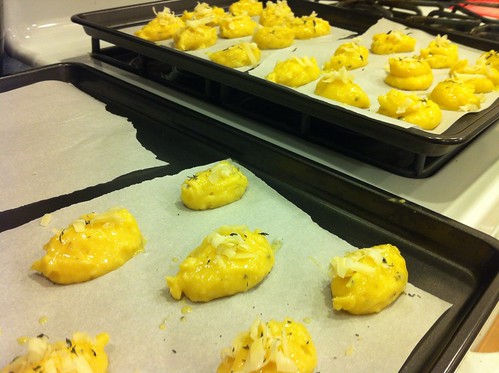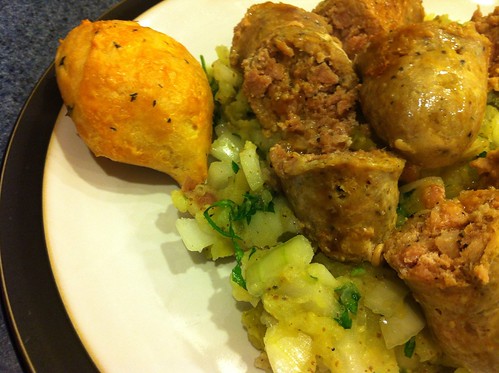I started off by reading the entire recipe because I wanted to make sure that everything was done according to instructions. I decided to set up my mise en place first, so that I could just add each thing as necessary without having to scramble. Butter, flour, salt, cayenne pepper, grated Gruyere, grated Asiago, and some thyme leaves, along with some eggs, and we were ready to go!
Okay, the first step was to boil a cup of water, with the 1/4 cup of butter. Once boiling, I poured the salt, cayenne pepper and flour into the pot and stirred vigorously until it all turned into a ball. It was kind of like a very large amount of roux, made very quickly!
From here, it was transferred to the standmixer, and stirred with the paddle attachment, with the grated cheeses, and then, one egg at a time, waiting until each was incorporated to add another. The recipe calls for a pastry bag, but I don't have one of those, so I decided to use another skill I have instead. Making a quenelle with two spoons, transferring a small amount of dough back and forth until it stays in a nice oval shape works just as well as putting all the dough into a pastry bag and piping it back out.
So I made my quenelles, one after the other, until all the dough was gone and my baking sheets were full! I brushed some egg on each quenelle, sprinkled the last of the grated gouda, and thyme leaves on top, and into a 400 degree oven they went, for 25 minutes.
While the gougeres were cooking, I worked on the main course: Sausage with Smashed Potatoes and Cornichons. It was perfect timing...it took about 25 minutes to make dinner, and 25 minutes to cook the gougeres, so everything came together at the same time. While dinner was delicious, the star of this meal were certainly the Thyme Gougeres!
They were easy to make, delicious to eat, and the perfect tidbit to throw in a basket for entertaining. In fact, the recipe even says that you can make them in advance, and freeze them to reheat later! I might just be keeping a batch of these on hand all the time!













